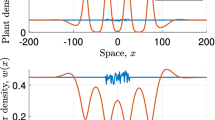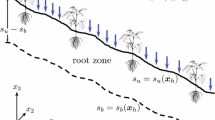Abstract
Vegetation patterns are a characteristic feature of semi-arid regions. On hillsides these patterns occur as stripes running parallel to the contours. The Klausmeier model, a coupled reaction–advection–diffusion system, is a deliberately simple model describing the phenomenon. In this paper, we replace the diffusion term describing plant dispersal by a more realistic nonlocal convolution integral to account for the possibility of long-range dispersal of seeds. Our analysis focuses on the rainfall level at which there is a transition between uniform vegetation and pattern formation. We obtain results, valid to leading order in the large parameter comparing the rate of water flow downhill to the rate of plant dispersal, for a negative exponential dispersal kernel. Our results indicate that both a wider dispersal of seeds and an increase in dispersal rate inhibit the formation of patterns. Assuming an evolutionary trade-off between these two quantities, mathematically motivated by the limiting behaviour of the convolution term, allows us to make comparisons to existing results for the original reaction–advection–diffusion system. These comparisons show that the nonlocal model always predicts a larger parameter region supporting pattern formation. We then numerically extend the results to other dispersal kernels, showing that the tendency to form patterns depends on the type of decay of the kernel.









Similar content being viewed by others
References
Allen EJ, Allen LJS, Gilliam X (1996) Dispersal and competition models for plants. J Math Biol 34(4):455–481
Aronson J, Kigel J, Shmida A (1993) Reproductive allocation strategies in desert and mediterranean populations of annual plants grown with and without water stress. Oecologia 93(3):336–342
Baudena M, Rietkerk M (2013) Complexity and coexistence in a simple spatial model for arid savanna ecosystems. Theor Ecol 6(2):131–141
Borgogno F, D’Odorico P, Laio F, Ridolfi L (2009) Mathematical models of vegetation pattern formation in ecohydrology. Rev Geophys 47:RG1005
Britton NF (1990) Spatial structures and periodic travelling waves in an integro-differential reaction–diffusion population model. SIAM J Appl Math 50(6):1663–1688
Bromley J, Brouwer J, Barker A, Gaze S, Valentine C (1997) The role of surface water redistribution in an area of patterned vegetation in a semi-arid environment, south-west Niger. J Hydrol 198(1):1–29
Bullock JM, González LM, Tamme R, Götzenberger L, White SM, Pärtel M, Hooftman DAP (2017) A synthesis of empirical plant dispersal kernels. J Ecol 105(1):6–19
Cooley JW, Lewis PAW, Welch PD (1969) The fast fourier transform and its applications. IEEE Trans Educ 12(1):27–34
Cornet A, Delhoume J, Montaña C (1988) Dynamics of striped vegetation patterns and water balance in the Chihuahuan Desert. In: During HJ, Werger MJA, Willems HJ (eds) Diversity and pattern in plant communities. SPB Academic Publishing, The Hague, pp 221–231
Cosner C, Dávila J, Martínez S (2012) Evolutionary stability of ideal free nonlocal dispersal. J Biol Dyn 6(2):395–405
Deblauwe V (2010) Modulation des structures de végétation auto-organisées en milieu aride. Ph.D. Thesis. Université Libre de Bruxelles
Dunkerley D, Brown K (2002) Oblique vegetation banding in the Australian arid zone: implications for theories of pattern evolution and maintenance. J Arid Environ 51(2):163–181
Ellner S, Shmida A (1981) Why are adaptations for long-range seed dispersal rare in desert plants? Oecologia 51(1):133–144
Gilad E, von Hardenberg J, Provenzale A, Shachak M, Meron E (2004) Ecosystem engineers: from pattern formation to habitat creation. Phys Rev Lett 93:098105
Gilad E, von Hardenberg J, Provenzale A, Shachak M, Meron E (2007) A mathematical model of plants as ecosystem engineers. J Theor Biol 244(4):680–691
Gourley SA, Chaplain MAJ, Davidson FA (2001) Spatio-temporal pattern formation in a nonlocal reaction–diffusion equation. Dyn Syst 16(2):173–192
Hemming CF (1965) Vegetation arcs in Somaliland. J Ecol 53(1):57–67
HilleRisLambers R, Rietkerk M, van den Bosch F, Prins HHT, de Kroon H (2001) Vegetation pattern formation in semi-arid grazing systems. Ecology 82(1):50–61
Hutson V, Martinez S, Mischaikow K, Vickers G (2003) The evolution of dispersal. J Math Biol 47(6):483–517
Johnson WC (1988) Estimating dispersibility of acer, fraxinus and tilia in fragmented landscapes from patterns of seedling establishment. Landscape Ecol 1(3):175–187
Kao CY, Lou Y, Shen W (2010) Random dispersal versus non-local dispersal. Discrete Contin Dyn Syst 26(2):551–596
Kealy BJ, Wollkind DJ (2012) A nonlinear stability analysis of vegetative turing pattern formation for an interaction–diffusion plant-surface water model system in an arid flat environment. Bull Math Biol 74(4):803–833
Kéfi S, Rietkerk M, Alados CL, Pueyo Y, Papanastasis V, ElAich A, de Ruiter P (2007) Spatial vegetation patterns and imminent desertification in mediterranean arid ecosystems. Nature 449(7159):213–217
Klausmeier CA (1999) Regular and irregular patterns in semiarid vegetation. Science 284(5421):1826–1828
Kletter A, von Hardenberg J, Meron E, Provenzale A (2009) Patterned vegetation and rainfall intermittency. J Theor Biol 256(4):574–583
Köppen W (1936) Das geographische System der Klimate, Handbuch der Klimatologie, vol 1. Verlag von Gebrüder Borntlaeger, Berlin
Lefever R, Barbier N, Couteron P, Lejeune O (2009) Deeply gapped vegetation patterns: on crown/root allometry, criticality and desertification. J Theor Biol 261(2):194–209
Lutscher F, Pachepsky E, Lewis MA (2005) The effect of dispersal patterns on stream populations. SIAM J Appl Math 47(4):749–772
Macfadyen WA (1950) Vegetation patterns in the semi-desert plains of British Somaliland. Geogr J 116(4/6):199–211
Merchant SM, Nagata W (2015) Selection and stability of wave trains behind predator invasions in a model with non-local prey competition. IMA J Appl Math 80(4):1155–1177
Meron E (2012) Pattern-formation approach to modelling spatially extended ecosystems. Ecol Modell 234:70–82
Mistro DC, Rodrigues LAD, Schmid AB (2005) A mathematical model for dispersal of an annual plant population with a seed bank. Ecol Modell 188(1):52–61
Montaña C (1992) The colonization of bare areas in two-phase mosaics of an arid ecosystem. J Ecol 80(2):315–327
Montaña C, Lopez-Portillo J, Mauchamp A (1990) The response of two woody species to the conditions created by a shifting ecotone in an arid ecosystem. J Ecol 78(3):789–798
Montaña C, Seghieri J, Cornet A (2001) Vegetation dynamics: recruitment and regeneration in two-phase mosaics. Springer, New York, pp 132–145
Neubert M, Kot M, Lewis M (1995) Dispersal and pattern formation in a discrete-time predator–prey model. Theor Popul Biol 48(1):7–43
Peel MC, Finlayson BL, McMahon TA (2007) Updated world map of the Köppen–Geiger climate classification. Hydrol Earth Syst Sci 11(5):1633–1644
Powell JA, Zimmermann NE (2004) Multiscale analysis of active seed dispersal contributes to resolving Reid’s paradox. Ecology 85(2):490–506
Pueyo Y, Kéfi S, Alados CL, Rietkerk M (2008) Dispersal strategies and spatial organization of vegetation in arid ecosystems. Oikos 117(10):1522–1532
Pueyo Y, Kéfi S, Dí-az-Sierra R, Alados C, Rietkerk M (2010) The role of reproductive plant traits and biotic interactions in the dynamics of semi-arid plant communities. Theor Popul Biol 78(4):289–297
Rietkerk M, van de Koppel J (2008) Regular pattern formation in real ecosystems. Trends Ecol Evol 23(3):169–175
Rietkerk M, Ketner P, Burger J, Hoorens B, Olff H (2000) Multiscale soil and vegetation patchiness along a gradient of herbivore impact in a semi-arid grazing system in West Africa. Plant Ecol 148(2):207–224
Rietkerk M, Boerlijst M, van Langevelde F, HilleRisLambers R, van de Koppel J, Kumar L, Prins H, de Roos A (2002) Self-organization of vegetation in arid ecosystems. Am Nat 160(4):524–530
Rietkerk M, Dekker SC, de Ruiter PC, van de Koppel J (2004) Self-organized patchiness and catastrophic shifts in ecosystems. Science 305(5692):1926–1929
Rodriguez-Iturbe I, Porporato A, Ridolfi L, Isham V, Coxi DR (1999) Probabilistic modelling of water balance at a point: the role of climate, soil and vegetation. Proc R Soc Lond A 455(1990):3789–3805
Saco PM, Willgoose GR, Hancock GR (2007) Eco-geomorphology of banded vegetation patterns in arid and semi-arid regions. Hydrol Earth Syst Sci 11(6):1717–1730
Salvucci GD (2001) Estimating the moisture dependence of root zone water loss using conditionally averaged precipitation. Water Resour Res 37(5):1357–1365
Sherratt JA (2005) An analysis of vegetation stripe formation in semi-arid landscapes. J Math Biol 51(2):183–197
Sherratt JA (2010) Pattern solutions of the Klausmeier model for banded vegetation in semi-arid environments I. Nonlinearity 23(10):2657
Sherratt JA (2011) Pattern solutions of the Klausmeier model for banded vegetation in semi-arid environments II: patterns with the largest possible propagation speeds. Proc R Soc Lond A 467(2135):3272–3294
Sherratt JA (2013a) Pattern solutions of the Klausmeier model for banded vegetation in semi-arid environments III: the transition between homoclinic solutions. Physica D 242(1):30–41
Sherratt JA (2013b) Pattern solutions of the Klausmeier model for banded vegetation in semiarid environments IV: slowly moving patterns and their stability. SIAM J Appl Math 73(1):330–350
Sherratt JA (2013c) Pattern solutions of the Klausmeier model for banded vegetation in semiarid environments V: the transition from patterns to desert. SIAM J Appl Math 73(4):1347–1367
Sherratt JA, Lord GJ (2007) Nonlinear dynamics and pattern bifurcations in a model for vegetation stripes in semi-arid environments. Theor Popul Biol 71(1):1–11
Siteur K, Siero E, Eppinga MB, Rademacher JD, Doelman A, Rietkerk M (2014) Beyond turing: the response of patterned ecosystems to environmental change. Ecol Complex 20:81–96
Thiery JM, D’Herbès JM, Valentin C (1995) A model simulating the genesis of banded vegetation patterns in Niger. J Ecol 83(3):497–507
Thompson S, Katul G (2009) Secondary seed dispersal and its role in landscape organization. Geophys Res Lett 36:L02402
Tongway DJ, Ludwig JA (1990) Vegetation and soil patterning in semi-arid mulga lands of Eastern Australia. Aust J Ecol 15(1):23–34
Valentin C, d’Herbès J, Poesen J (1999) Soil and water components of banded vegetation patterns. CATENA 37(1–2):1–24
van Oudtshoorn KVR, van Rooyen MW (2013) Dispersal biology of desert plants adaptations of desert organisms. Springer, Berlin
vande Koppel J, Rietkerk M, van Langevelde F, Kumar L, Klausmeier CA, Fryxell JM, Hearne JW, van Andel J, de Ridder N, Skidmore A, Stroosnijder L, Prins HHT, Lundberg Associate Editor: Per (2002) Spatial heterogeneity and irreversible vegetation change in semiarid grazing systems. Am Nat 159(2):209–218
vander Stelt S, Doelman A, Hek G, Rademacher JDM (2013) Rise and fall of periodic patterns for a generalized Klausmeier–Gray–Scott model. J Nonlinear Sci 23(1):39–95
Volis S (2007) Correlated patterns of variation in phenology and seed production in populations of two annual grasses along an aridity gradient. Evol Ecol 21(3):381–393
von Hardenberg J, Kletter AY, Yizhaq H, Nathan J, Meron E (2010) Periodic versus scale-free patterns in dryland vegetation. Proc R Soc Lond B 277(1688):1771–1776
White LP (1971) Vegetation stripes on sheet wash surfaces. J Ecol 59(2):615–622
Worrall GA (1959) The Butana grass patterns. J Soil Sci 10(1):34–53
Zelnik YR, Kinast S, Yizhaq H, Bel G, Meron E (2013) Regime shifts in models of dryland vegetation. Philos Trans R Soc Lond A 371(2004):20120358
Acknowledgements
Funding was provided by Engineering and Physical Sciences Research Council (Grant No. EP/L016508/01), Scottish Funding Council, University of Edinburgh and Heriot-Watt University.
Author information
Authors and Affiliations
Corresponding author
Additional information
Lukas Eigentler was supported by The Maxwell Institute Graduate School in Analysis and its Applications, a Centre for Doctoral Training funded by the UK Engineering and Physical Sciences Research Council (Grant EP/L016508/01), the Scottish Funding Council, Heriot-Watt University and the University of Edinburgh.
Rights and permissions
About this article
Cite this article
Eigentler, L., Sherratt, J.A. Analysis of a model for banded vegetation patterns in semi-arid environments with nonlocal dispersal. J. Math. Biol. 77, 739–763 (2018). https://doi.org/10.1007/s00285-018-1233-y
Received:
Revised:
Published:
Issue Date:
DOI: https://doi.org/10.1007/s00285-018-1233-y




